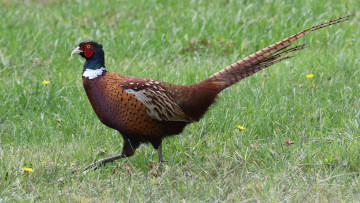Nature Notes

PHOTO COURTESY OF GARRY KESSLER
Male ring-necked pheasant
November 15, 2022
NATURE NOTES
By Annie Reid
Westborough Community Land Trust
Fall’s wild pheasants
You’ve probably heard of pheasants, but have you seen one? Ever heard one? Ever found a feather from one? Ever tasted one?
Your chances of seeing a pheasant increase in late fall. Our ring-necked pheasants (Phasianus colchicus) are elusive, non-native game birds, but you don’t have to be a hunter to glimpse one. Males are colorful and flashy year-round, while females are camouflaged in browns. Many more pheasants are around in the fall, because every year MassWildlife stocks many wildlife management areas with pheasants for hunting. That includes our local MacCallum Wildlife Management Area (Westborough). About 40,000 pheasants are stocked statewide every fall. Ring-necked pheasants are good at running and hiding, and like deer and foxes, some find their way to safe places where hunting is not allowed. That place might be a field, brushy area, cattail marsh, or roadside near you.
What do ring-necked pheasants look like? These large, chicken-like birds are 2-3 feet long, including a long, 16-inch tail (about twice as long as their short, rounded wings). They weigh 2-7 pounds. Males are showy with a white neck ring, red face, blue-green neck, maroon breast, coppery sides and back, and an iridescent sheen at times. Females are somewhat smaller with a dull, mottled brown appearance and a shorter tail.
Ring-necked pheasants don’t migrate. They’re suited for winter survival. They are insulated with special down-like “afterfeathers” under their regular body feathers. They forage on the ground, scratching with their feet, pecking and digging in the dirt with their beaks. This works in winter with fewer than five inches of snow. For winter, they form small, same-sex flocks, gathering in groups of about two males or five females. In very cold weather, they’re less active and can lower their body temperature and slow their metabolism to conserve energy.
What is a day in the life of a pheasant like? Pheasants are basically ground dwellers. After spending the night in dense brushy cover, they come into the open to feed in the morning. They roost in different cover to rest during the middle of the day, and feed again late in the day. At this time of year, they often forage for waste grain in agricultural fields, especially for corn but also soybeans, sorghum, ragweed seeds, and more. If a hunter, bird dog, or wild predator comes near, they stay motionless in brush. But they can and do fly. At the last minute, they can flush, bursting into the air and flying to cover elsewhere, thanks to powerful breast muscles.
Males and females make 16-24 different calls for various purposes, but you’re most likely to hear a male crowing a squawk-like caw-CAWK (https://allaboutbirds.org/guide/Ring-necked_Pheasant/sounds). In early spring, males increase their crowing to claim territories and attract females. Many males have just one mate, but others have a “harem” of females living and feeding within the male’s territory.
Females nest on the ground, often just outside the male’s territory. They prefer hay fields, weed fields, or forest edges. Females scratch a shallow depression in the ground and line it with nearby grass, leaves, and some breast feathers. They lay 7-15 olive-brown eggs, which they incubate for 24 days.
In June, pheasant chicks hatch ready to go. They’re covered with down, their eyes are open, and their legs are strong enough for them to leave the nest within a day, following their mother to food, which they pick up by themselves. They devour insects for the protein needed for growth. Chicks can fly a few feet after 12 days, and are on their own at 10-11 weeks old.
How did ring-necked pheasants get here? They originated in China 1.19 million years ago. They’ve spread and diversified into 30 subspecies adapted to various habitats around the world. They were introduced in Massachusetts in 1897-1898.
Humans are responsible for introducing pheasants beyond their native Eurasian range, mainly as game birds. In the U.S., ring-necked pheasants were first successfully introduced in Oregon from Asia in 1882 and in New Jersey from Europe in 1887. The ring-necked pheasant is the state bird of South Dakota. If you look at quarters, you’ll find it represented on South Dakota’s quarter.
Numbers of ring-necked pheasants have declined in the U.S. by more than 25% over the last 50 years. A major reason is changing land use, which has led to habitat loss. Small farms with diverse crops on a patchwork of fields and brushy areas have been replaced by large farms growing single crops on large fields lacking nearby cover. Losses of adult pheasants to hunting and nests to early-season mowing (before mid-July) may be somewhat offset by re-stocking efforts. Concerns about re-stocking include worries about changing the genetics of local populations and about introducing pen-raised pheasants that may not be suited to local conditions.
Keep your eyes open for pheasants this fall. Be aware that the Massachusetts hunting season for pheasants runs Oct.15-Nov. 26 (no hunting on Sundays), so wear blaze orange if you venture into areas where hunting is allowed.
Date index
Month (November)
Common name index
Scientific name index
Category index